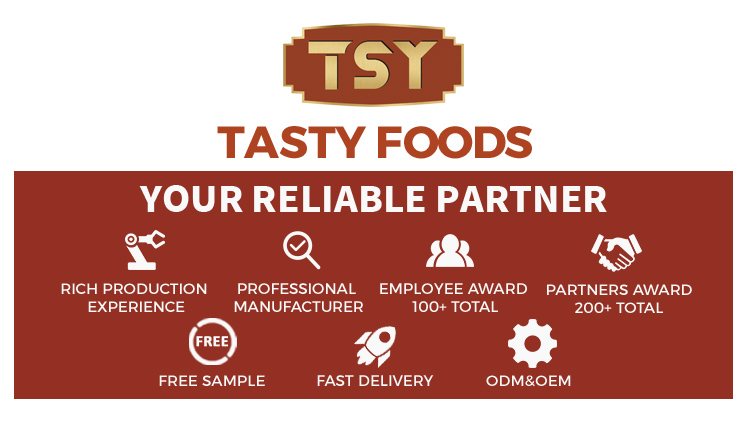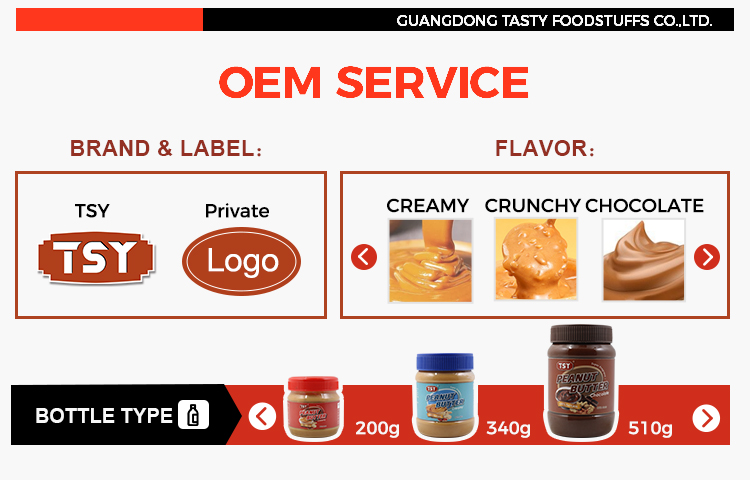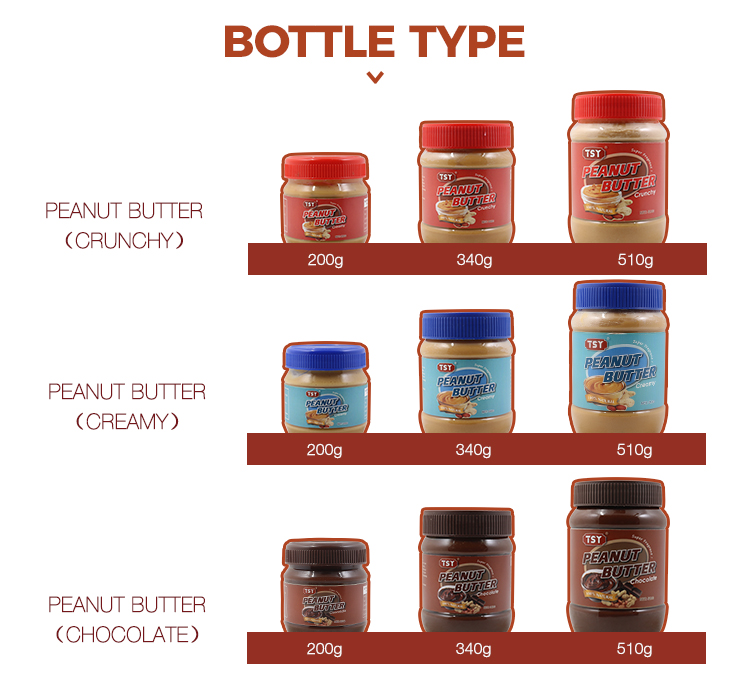TSY or Custom Brands
| Availability: | |
|---|---|
| Quantity: | |








Parameters About TSY Smooth Creamy Peanut Butter
| Appearance | Smooth creamy peanut butter has a smooth, velvety texture with a consistent, spreadable consistency. Its appearance is a light to medium tan color. |
| Flavor | In terms of taste, it offers a well-balanced combination of nuttiness, sweetness, and a hint of saltiness. |
| Ingredient | Peanuts, Glycerol Monostearate, Salt, Sugar |
| Serving Suggestion | The creamy texture makes smooth creamy peanut butter a popular choice for spreading on sandwich, bread, crackers, or incorporating into various recipes, providing a satisfying and rich peanut flavor. |
| Nutrition information typical values per 100g | Energy 2655kJ/635Kcal Protein 22.1g Total Fat 50.8g Carbohydrate 23.5g Sodium 560mg |
| Shelf Life | 24 months |
| STORAGE: | Keep at room temperature and moisture proof storage. Please closed After opening use,and store in dry cool place. |
| Certificate | HACCP, BRC, IFS, HALAL, KOSHER, ISO |

Creamy peanut butter is a popular dipping sauce for sandwiches because of its rich, smooth texture and delicious flavor that complements a wide variety of sandwich fillings. Here are some reasons why it's commonly used as a dipping sauce:
1. Creaminess: The smooth texture of creamy peanut butter makes it an ideal dipping sauce as it spreads easily and coats the sandwich ingredients, providing a creamy and consistent flavor in every bite.
2. Balanced Flavor: Creamy peanut butter has a well-balanced taste, combining the natural sweetness of peanuts with a subtle nuttiness. This balanced flavor profile pairs well with various sandwich fillings, enhancing their taste without overpowering them.
3. Nutty Enhancements: The nutty flavor of peanut butter can complement both sweet and savory sandwich fillings. It adds a pleasant nuttiness that can enhance the taste of ingredients like ham, turkey, cheese, or even fruits like bananas or apples.
4. Quick and Convenient: Using creamy peanut butter as a dipping sauce is quick and easy. It doesn't require any complex preparation, and you can enjoy it instantly by simply dipping your sandwich into a jar of peanut butter.
5. Versatility: Creamy peanut butter can be used as a dipping sauce for a wide range of sandwiches, from classic combinations like peanut butter and jelly to more adventurous pairings with vegetables, grilled chicken, or even tofu.
6. Nutrition: Peanut butter contains healthy fats, protein, and essential nutrients like Vitamin E, magnesium, and potassium, making it a nutritious addition to sandwiches.
Overall, the popularity of creamy peanut butter as a dipping sauce for sandwiches is due to its convenience, versatility, and delightful flavor, making it a favorite choice for both kids and adults alike.
Here’s a nutritious and creative guide to using peanut butter beyond just sandwiches:
Why It’s Great:
✅ High in plant-based protein (7g per 2 tbsp)
✅ Rich in healthy fats & fiber
✅ Packed with vitamin E, magnesium, and antioxidants
Overnight Oats: Mix 1 tbsp with oats, chia seeds, and almond milk.
Smoothies: Blend with banana, spinach, and cocoa powder.
Toast Topper: Spread on whole-grain toast + sliced strawberries.
Thai Peanut Sauce: Whisk with coconut milk, soy sauce, and lime.
Stir-Fry Glaze: Toss with tofu, veggies, and sriracha.
Marinade: Combine with garlic, honey, and ginger for chicken.
Energy Balls: Roll with oats, honey, and dark chocolate chips.
Apple Dip: Mix with Greek yogurt and cinnamon.
Frozen Bananas: Dip in peanut butter, freeze.
Butter Substitute: In baking (cookies, muffins).
Salad Dressing: Thin with water, lime, and soy sauce.
Pro Tip: Choose natural peanut butter (just peanuts + salt) to avoid added sugars and oils.
Parameters About TSY Smooth Creamy Peanut Butter
| Appearance | Smooth creamy peanut butter has a smooth, velvety texture with a consistent, spreadable consistency. Its appearance is a light to medium tan color. |
| Flavor | In terms of taste, it offers a well-balanced combination of nuttiness, sweetness, and a hint of saltiness. |
| Ingredient | Peanuts, Glycerol Monostearate, Salt, Sugar |
| Serving Suggestion | The creamy texture makes smooth creamy peanut butter a popular choice for spreading on sandwich, bread, crackers, or incorporating into various recipes, providing a satisfying and rich peanut flavor. |
| Nutrition information typical values per 100g | Energy 2655kJ/635Kcal Protein 22.1g Total Fat 50.8g Carbohydrate 23.5g Sodium 560mg |
| Shelf Life | 24 months |
| STORAGE: | Keep at room temperature and moisture proof storage. Please closed After opening use,and store in dry cool place. |
| Certificate | HACCP, BRC, IFS, HALAL, KOSHER, ISO |

Creamy peanut butter is a popular dipping sauce for sandwiches because of its rich, smooth texture and delicious flavor that complements a wide variety of sandwich fillings. Here are some reasons why it's commonly used as a dipping sauce:
1. Creaminess: The smooth texture of creamy peanut butter makes it an ideal dipping sauce as it spreads easily and coats the sandwich ingredients, providing a creamy and consistent flavor in every bite.
2. Balanced Flavor: Creamy peanut butter has a well-balanced taste, combining the natural sweetness of peanuts with a subtle nuttiness. This balanced flavor profile pairs well with various sandwich fillings, enhancing their taste without overpowering them.
3. Nutty Enhancements: The nutty flavor of peanut butter can complement both sweet and savory sandwich fillings. It adds a pleasant nuttiness that can enhance the taste of ingredients like ham, turkey, cheese, or even fruits like bananas or apples.
4. Quick and Convenient: Using creamy peanut butter as a dipping sauce is quick and easy. It doesn't require any complex preparation, and you can enjoy it instantly by simply dipping your sandwich into a jar of peanut butter.
5. Versatility: Creamy peanut butter can be used as a dipping sauce for a wide range of sandwiches, from classic combinations like peanut butter and jelly to more adventurous pairings with vegetables, grilled chicken, or even tofu.
6. Nutrition: Peanut butter contains healthy fats, protein, and essential nutrients like Vitamin E, magnesium, and potassium, making it a nutritious addition to sandwiches.
Overall, the popularity of creamy peanut butter as a dipping sauce for sandwiches is due to its convenience, versatility, and delightful flavor, making it a favorite choice for both kids and adults alike.
Here’s a nutritious and creative guide to using peanut butter beyond just sandwiches:
Why It’s Great:
✅ High in plant-based protein (7g per 2 tbsp)
✅ Rich in healthy fats & fiber
✅ Packed with vitamin E, magnesium, and antioxidants
Overnight Oats: Mix 1 tbsp with oats, chia seeds, and almond milk.
Smoothies: Blend with banana, spinach, and cocoa powder.
Toast Topper: Spread on whole-grain toast + sliced strawberries.
Thai Peanut Sauce: Whisk with coconut milk, soy sauce, and lime.
Stir-Fry Glaze: Toss with tofu, veggies, and sriracha.
Marinade: Combine with garlic, honey, and ginger for chicken.
Energy Balls: Roll with oats, honey, and dark chocolate chips.
Apple Dip: Mix with Greek yogurt and cinnamon.
Frozen Bananas: Dip in peanut butter, freeze.
Butter Substitute: In baking (cookies, muffins).
Salad Dressing: Thin with water, lime, and soy sauce.
Pro Tip: Choose natural peanut butter (just peanuts + salt) to avoid added sugars and oils.
According to the different tastes and qualities requirements of different customers, we offer Creamy Peanut Butter, Crunchy Peanut Butter, Chocolate Peanut Butter for choice.


| SPECIFIATION PER CTN | PACKS TYPE | CARTON SIZE (CM) | G.WEIGHT (KGS) /CTN |
| 200g*24tins | Plastic Bottle | 28*21.3*16.5 | 5.80 |
| 340g*24tins | Plastic Bottle | 30.4*23.2*20.7 | 9.40 |
| 510g*24tins | Plastic Bottle | 32.8*24.8*25.7 | 14.20 |
| 1kg*12tins | Plastic Bottle | 38.8*29*17 | 13.00 |
* If you have other needs, please consult us.
According to the different tastes and qualities requirements of different customers, we offer Creamy Peanut Butter, Crunchy Peanut Butter, Chocolate Peanut Butter for choice.


| SPECIFIATION PER CTN | PACKS TYPE | CARTON SIZE (CM) | G.WEIGHT (KGS) /CTN |
| 200g*24tins | Plastic Bottle | 28*21.3*16.5 | 5.80 |
| 340g*24tins | Plastic Bottle | 30.4*23.2*20.7 | 9.40 |
| 510g*24tins | Plastic Bottle | 32.8*24.8*25.7 | 14.20 |
| 1kg*12tins | Plastic Bottle | 38.8*29*17 | 13.00 |
* If you have other needs, please consult us.
Peanut butter is a nutrient-rich food that offers several essential nutrients. Here are some key nutrients found in peanut butter:
1. Protein: Peanut butter is a good source of protein, which is essential for building and repairing tissues in the body.
2. Healthy Fats: It contains monounsaturated and polyunsaturated fats, which are heart-healthy fats that can help reduce bad cholesterol levels.
3. Fiber: Peanut butter provides dietary fiber, which aids in digestion and can help with weight management.
4. Vitamins: It contains various vitamins such as vitamin E, which is an antioxidant, and B vitamins that play roles in energy production.
5. Minerals: Peanut butter contains minerals like magnesium, potassium, and phosphorus, which are important for various bodily functions.
6. Antioxidants: It contains antioxidants like resveratrol, which can help protect the body's cells from damage.
It's worth noting that while peanut butter is nutrient-rich, it is also calorie-dense, so portion control is essential, especially if you are watching your calorie intake. Additionally, some peanut butter brands may contain added sugars or unhealthy fats, so it's a good idea to read the label and opt for natural or organic varieties when possible.
Creamy peanut butter is produced through a relatively simple process that involves several steps to turn roasted peanuts into a smooth and creamy spread. Here's a general overview of how it's made:
1. Roasting: Raw peanuts are first roasted to enhance their flavor and bring out the natural oils. The peanuts are placed in an oven or a specialized roasting machine and heated until they reach the desired color and taste.
2. Cooling: After roasting, the peanuts are allowed to cool down to room temperature. This step is essential to prevent the nuts from getting too hot during the grinding process.
3.Shelling: Once cooled, the peanuts are typically shelled to remove the outer skin. This step is optional, as some manufacturers may choose to leave the skins on for added fiber and texture.
4. Grinding: The roasted peanuts, whether shelled or with skins on, are then fed into grinding machines. These machines crush the peanuts, turning them into a thick and coarse paste.
5. Creaming: To achieve a smooth and creamy texture, the coarse peanut paste goes through further processing. It is continuously ground and mixed to break down the peanut particles and release their oils, resulting in a much smoother consistency.
6. Additional Ingredients: Depending on the recipe and brand, some manufacturers may add other ingredients like salt, sugar, or stabilizers at this stage to enhance the flavor and texture of the creamy peanut butter.
7. Packaging: Once the desired consistency is achieved, the creamy peanut butter is transferred to jars or containers for packaging and distribution.
It's important to note that different brands may have slight variations in their production processes, and some may choose to use additional or fewer ingredients based on their unique recipes. The key goal remains consistent: to create a smooth and delicious peanut butter that people can enjoy on sandwiches, in recipes, or as a dip.
Peanut butter is a nutrient-rich food that offers several essential nutrients. Here are some key nutrients found in peanut butter:
1. Protein: Peanut butter is a good source of protein, which is essential for building and repairing tissues in the body.
2. Healthy Fats: It contains monounsaturated and polyunsaturated fats, which are heart-healthy fats that can help reduce bad cholesterol levels.
3. Fiber: Peanut butter provides dietary fiber, which aids in digestion and can help with weight management.
4. Vitamins: It contains various vitamins such as vitamin E, which is an antioxidant, and B vitamins that play roles in energy production.
5. Minerals: Peanut butter contains minerals like magnesium, potassium, and phosphorus, which are important for various bodily functions.
6. Antioxidants: It contains antioxidants like resveratrol, which can help protect the body's cells from damage.
It's worth noting that while peanut butter is nutrient-rich, it is also calorie-dense, so portion control is essential, especially if you are watching your calorie intake. Additionally, some peanut butter brands may contain added sugars or unhealthy fats, so it's a good idea to read the label and opt for natural or organic varieties when possible.
Creamy peanut butter is produced through a relatively simple process that involves several steps to turn roasted peanuts into a smooth and creamy spread. Here's a general overview of how it's made:
1. Roasting: Raw peanuts are first roasted to enhance their flavor and bring out the natural oils. The peanuts are placed in an oven or a specialized roasting machine and heated until they reach the desired color and taste.
2. Cooling: After roasting, the peanuts are allowed to cool down to room temperature. This step is essential to prevent the nuts from getting too hot during the grinding process.
3.Shelling: Once cooled, the peanuts are typically shelled to remove the outer skin. This step is optional, as some manufacturers may choose to leave the skins on for added fiber and texture.
4. Grinding: The roasted peanuts, whether shelled or with skins on, are then fed into grinding machines. These machines crush the peanuts, turning them into a thick and coarse paste.
5. Creaming: To achieve a smooth and creamy texture, the coarse peanut paste goes through further processing. It is continuously ground and mixed to break down the peanut particles and release their oils, resulting in a much smoother consistency.
6. Additional Ingredients: Depending on the recipe and brand, some manufacturers may add other ingredients like salt, sugar, or stabilizers at this stage to enhance the flavor and texture of the creamy peanut butter.
7. Packaging: Once the desired consistency is achieved, the creamy peanut butter is transferred to jars or containers for packaging and distribution.
It's important to note that different brands may have slight variations in their production processes, and some may choose to use additional or fewer ingredients based on their unique recipes. The key goal remains consistent: to create a smooth and delicious peanut butter that people can enjoy on sandwiches, in recipes, or as a dip.